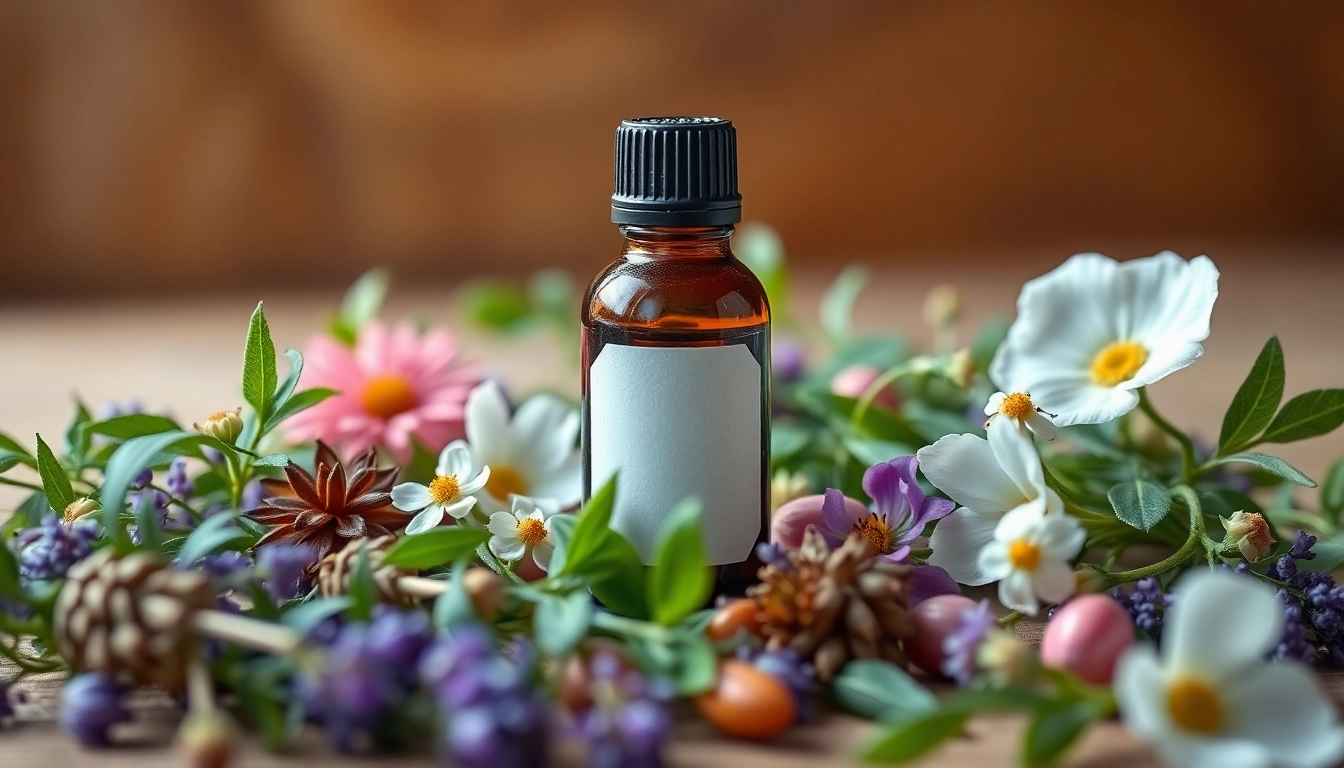Understanding Essential Oils: Basics and Benefits
What are Essential Oils?
Essential oils are concentrated extracts derived from plants, capturing the plant’s characteristic fragrance and beneficial properties. These aromatic compounds are obtained from various parts of plants, including flowers, leaves, stems, and roots. The process of extraction yields potent essences that have been utilized for centuries in traditional medicine, cosmetics, and aromatherapy. From their rich histories in ancient cultures to their modern applications, essential oils have become a beloved component of wellness practices around the world.
Unlike synthetic fragrances, which may include harmful chemicals, essential oils offer a natural alternative. Each essential oil possesses unique properties that can affect mood, physical health, and overall well-being. As more individuals seek holistic remedies, interest in these powerful plant extracts continues to grow. In fact, the market for essential oils is expected to reach unprecedented heights as awareness of their benefits spreads.
Key Benefits of Using Essential Oils
Utilizing essential oils offers a range of benefits, making them a versatile addition to daily routines. Here are some of the key advantages:
- Promoting Relaxation and Reducing Stress: Aromatherapy, which employs essential oils, is known for its calming effects. Oils like lavender can reduce anxiety and promote restful sleep.
- Enhancing Mood: Essential oils such as citrus oils can uplift mood and invigorate the senses. They often help alleviate symptoms of depression and enhance overall emotional well-being.
- Supporting Physical Health: Some essential oils have demonstrated antibacterial, antiviral, and antifungal properties. For instance, tea tree oil is renowned for its ability to combat skin infections.
- Boosting Cognitive Functions: Certain oils, like rosemary, may enhance memory and concentration, making them ideal for studying or working environments.
How Essential Oils Are Extracted
The extraction of essential oils is an art as much as it is a science. The most common methods used include:
- Steam Distillation: This is the most prevalent method, where steam passes through plant material, vaporizing the volatile compounds which are then condensed back into liquid form.
- Cold Press Extraction: Primarily used for citrus fruits, this technique involves mechanically pressing the rind to release the aromatic oils.
- Solvent Extraction: Here, a solvent is utilized to extract essential oils, ideal for delicate flowers that cannot withstand heat. The process leaves behind a waxy substance known as an absolute.
- CO2 Extraction: This method uses carbon dioxide at high pressure and low temperature, preserving the full spectrum of plant compounds and ensuring a high-quality oil.
Popular Essential Oils and Their Uses
Lavender Essential Oil: A Soothing Companion
Lavender essential oil is perhaps one of the most well-known and widely used essential oils. Its calming aroma not only relaxes the mind but has been shown to help individuals fall asleep more easily. Lavender oil can be used in various ways, including:
- Aromatherapy Diffusers: Adding a few drops to a diffuser can create a tranquil environment for relaxation or meditation.
- Topical Application: When diluted properly, lavender oil can be applied to the skin to soothe minor burns, insect bites, and even headaches.
- Bathing: Incorporating lavender oil into a warm bath can enhance the soothing effects, providing a perfect end to a stressful day.
Peppermint Essential Oil: Revitalizing and Refreshing
Peppermint essential oil is revered for its invigorating properties. Known for its ability to boost energy and enhance focus, it is frequently used in workplaces and study sessions. Here are some practical uses:
- Energy Boost: Inhaling peppermint oil can stimulate the mind and increase alertness.
- Digestive Aid: A diluted application to the abdomen can relieve indigestion and gas discomfort.
- Headache Relief: Applying a diluted formulation to temples can help relieve tension headaches.
Lemon Essential Oil: Uplifting Properties for Mood
Lemon essential oil is well-known for its crisp, clean aroma that can lighten up spirits and clear the mind. Its bright scent not only elevates mood but also possesses numerous health benefits:
- Refreshing Environment: Diffusing lemon oil can enhance the ambiance of any room, leaving it smelling fresh and inviting.
- Natural Cleaner: With its antibacterial properties, lemon oil is an excellent natural cleaner and can be added to household cleaning products.
- Culinary Uses: A few drops can add zest to various recipes, creating an aromatic and flavorful dish.
Essential Oil Safety and Usage Guidelines
Dilution and Application Methods
While essential oils are powerful, they must be used with care. Diluting essential oils is crucial to minimize potential irritation and adverse reactions. Most oils should be diluted in a carrier oil (like coconut or jojoba oil) before topical application. A general guideline is to use:
- 2-3 drops of essential oil per teaspoon of carrier oil for adults.
- 1 drop per teaspoon for children or those with sensitive skin.
A patch test is recommended before widespread use; apply a small amount of diluted oil on the inner forearm and monitor for any reactions.
Potential Side Effects and Precautions
Despite their natural origins, essential oils can cause side effects in some individuals. Common issues may include:
- Skin Irritation: Essential oils can irritate the skin, especially if not diluted properly.
- Allergic Reactions: Some people may experience allergic reactions, leading to rashes or respiratory issues.
- Photosensitivity: Citrus oils can make the skin sensitive to sunlight, leading to increased risk of burns.
Always consult a healthcare professional before using essential oils if you are pregnant, nursing, or taking medications.
Storage and Shelf Life of Essential Oils
Proper storage of essential oils is vital to maintain their integrity and potency. Here are some essential oil storage tips:
- Cool, Dark Place: Store oils away from heat and light, ideally in dark glass bottles to prevent degradation.
- Tightly Sealed Containers: Ensure bottles are tightly sealed to prevent evaporation and contamination.
- Know Your Oils: Most essential oils have a shelf life between 1-5 years, but citrus oils are best used within 1-2 years.
Incorporating Essential Oils into Your Daily Routine
Essential Oils for Aromatherapy
Aromatherapy is one of the most popular applications for essential oils. It works by stimulating the olfactory system, which connects directly to the brain’s limbic system — the area responsible for emotions, memories, and feelings. Here are effective ways to incorporate aromatherapy:
- Diffusers: Using a diffuser can disperse essential oils into the air, making them easy to inhale as you go about your daily activities.
- Inhalers: Personal inhalers allow for on-the-go aromatherapy, making it simple to enjoy your favorite oils anytime.
- Baths: Adding essential oils to a warm bath creates a soothing atmosphere, enhancing relaxation.
Using Essential Oils in Skincare
Essential oils can also play a significant role in skincare routines. With their potent properties, they can address various skin concerns:
- Acne Treatment: Tea tree oil is widely recognized for its ability to reduce acne-causing bacteria.
- Anti-Aging Benefits: Oils like frankincense may help minimize the appearance of fine lines and rejuvenate the skin.
- Moisturizing: Lavender and rose oils can serve as natural moisturizers.
Always blend with a carrier oil to ensure safe application on the skin.
Cooking with Essential Oils: What You Need to Know
Culinary uses of essential oils are gaining traction, but caution is essential. Only high-quality food-grade oils should be used in cooking. Here are a few points to consider:
- Use Sparingly: Because essential oils are concentrated, only a drop or two is needed to flavor dishes effectively.
- Complementing Flavors: Oils can harmonize with spices and herbs; for example, lemon and peppermint oils are complementary in desserts.
- Recipe Adaptations: When substituting oils for fresh herbs, remember that the concentration is significantly higher, so adjust quantities accordingly.
Advanced Techniques and Tips for Essential Oil Enthusiasts
Blending Essential Oils for Unique Fragrances
Creating your own essential oil blends can be a fun and rewarding experience. Here are some tips for successful blending:
- Understand Notes: Essential oils can be categorized into top, middle, and base notes. Top notes (like lemon) offer the first impression, middle notes (like lavender) form the body of the fragrance, and base notes (like sandalwood) provide lasting depth.
- Start Simple: When first experimenting with blends, start with 2-3 oils until you understand their interactions.
- Keep Notes: Document your blends to replicate successful combinations and refine those that don’t work.
Essential Oils in DIY Household Products
Beyond personal care, essential oils can be powerhouses in household cleaning products—offering effective, natural alternatives to chemical-laden solutions:
- All-Purpose Cleaner: Combine vinegar, water, and your choice of essential oil (like lemon or tea tree) to create a multi-surface cleaner.
- Air Fresheners: Essential oils can naturally purify and fragrance the air. A simple mix of water and oil in a spray bottle works wonders.
- Odor Neutralizers: Adding essential oils to laundry can help freshen clothes while eliminating odors.
Measuring Effectiveness: Essential Oil Metrics and Assessment
To evaluate the effectiveness of different essential oils, consider the following approaches:
- Personal Journals: Keeping a log of how specific oils impact mood, physical symptoms, or skin conditions can help track their effectiveness over time.
- Professional Assessment: Consult with aromatherapists or holistic practitioners for tailored advice and to gauge oil efficacy.
- Surveys and Feedback: Gathering anecdotal feedback from others who use essential oils can provide comparative insights and enhance your understanding.



